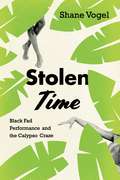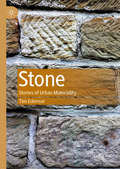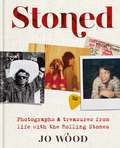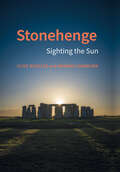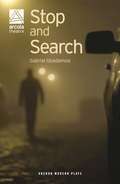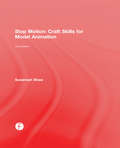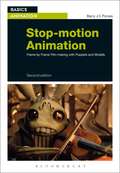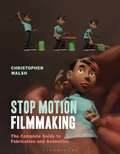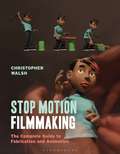- Table View
- List View
Stolen Time: Black Fad Performance and the Calypso Craze
by Shane VogelIn 1956 Harry Belafonte’s Calypso became the first LP to sell more than a million copies. For a few fleeting months, calypso music was the top-selling genre in the US—it even threatened to supplant rock and roll. Stolen Time provides a vivid cultural history of this moment and outlines a new framework—black fad performance—for understanding race, performance, and mass culture in the twentieth century United States. Vogel situates the calypso craze within a cycle of cultural appropriation, including the ragtime craze of 1890s and the Negro vogue of the 1920s, that encapsulates the culture of the Jim Crow era. He follows the fad as it moves defiantly away from any attempt at authenticity and shamelessly embraces calypso kitsch. Although white calypso performers were indeed complicit in a kind of imperialist theft of Trinidadian music and dance, Vogel argues, black calypso craze performers enacted a different, and subtly subversive, kind of theft. They appropriated not Caribbean culture itself, but the US version of it—and in so doing, they mocked American notions of racial authenticity. From musical recordings, nightclub acts, and television broadcasts to Broadway musicals, film, and modern dance, he shows how performers seized the ephemeral opportunities of the fad to comment on black cultural history and even question the meaning of race itself.
Stolen Time: Black Fad Performance and the Calypso Craze
by Shane VogelIn 1956 Harry Belafonte’s Calypso became the first LP to sell more than a million copies. For a few fleeting months, calypso music was the top-selling genre in the US—it even threatened to supplant rock and roll. Stolen Time provides a vivid cultural history of this moment and outlines a new framework—black fad performance—for understanding race, performance, and mass culture in the twentieth century United States. Vogel situates the calypso craze within a cycle of cultural appropriation, including the ragtime craze of 1890s and the Negro vogue of the 1920s, that encapsulates the culture of the Jim Crow era. He follows the fad as it moves defiantly away from any attempt at authenticity and shamelessly embraces calypso kitsch. Although white calypso performers were indeed complicit in a kind of imperialist theft of Trinidadian music and dance, Vogel argues, black calypso craze performers enacted a different, and subtly subversive, kind of theft. They appropriated not Caribbean culture itself, but the US version of it—and in so doing, they mocked American notions of racial authenticity. From musical recordings, nightclub acts, and television broadcasts to Broadway musicals, film, and modern dance, he shows how performers seized the ephemeral opportunities of the fad to comment on black cultural history and even question the meaning of race itself.
Stolen Time: Black Fad Performance and the Calypso Craze
by Shane VogelIn 1956 Harry Belafonte’s Calypso became the first LP to sell more than a million copies. For a few fleeting months, calypso music was the top-selling genre in the US—it even threatened to supplant rock and roll. Stolen Time provides a vivid cultural history of this moment and outlines a new framework—black fad performance—for understanding race, performance, and mass culture in the twentieth century United States. Vogel situates the calypso craze within a cycle of cultural appropriation, including the ragtime craze of 1890s and the Negro vogue of the 1920s, that encapsulates the culture of the Jim Crow era. He follows the fad as it moves defiantly away from any attempt at authenticity and shamelessly embraces calypso kitsch. Although white calypso performers were indeed complicit in a kind of imperialist theft of Trinidadian music and dance, Vogel argues, black calypso craze performers enacted a different, and subtly subversive, kind of theft. They appropriated not Caribbean culture itself, but the US version of it—and in so doing, they mocked American notions of racial authenticity. From musical recordings, nightclub acts, and television broadcasts to Broadway musicals, film, and modern dance, he shows how performers seized the ephemeral opportunities of the fad to comment on black cultural history and even question the meaning of race itself.
Stolen Time: Black Fad Performance and the Calypso Craze
by Shane VogelIn 1956 Harry Belafonte’s Calypso became the first LP to sell more than a million copies. For a few fleeting months, calypso music was the top-selling genre in the US—it even threatened to supplant rock and roll. Stolen Time provides a vivid cultural history of this moment and outlines a new framework—black fad performance—for understanding race, performance, and mass culture in the twentieth century United States. Vogel situates the calypso craze within a cycle of cultural appropriation, including the ragtime craze of 1890s and the Negro vogue of the 1920s, that encapsulates the culture of the Jim Crow era. He follows the fad as it moves defiantly away from any attempt at authenticity and shamelessly embraces calypso kitsch. Although white calypso performers were indeed complicit in a kind of imperialist theft of Trinidadian music and dance, Vogel argues, black calypso craze performers enacted a different, and subtly subversive, kind of theft. They appropriated not Caribbean culture itself, but the US version of it—and in so doing, they mocked American notions of racial authenticity. From musical recordings, nightclub acts, and television broadcasts to Broadway musicals, film, and modern dance, he shows how performers seized the ephemeral opportunities of the fad to comment on black cultural history and even question the meaning of race itself.
Stolen Time: Black Fad Performance and the Calypso Craze
by Shane VogelIn 1956 Harry Belafonte’s Calypso became the first LP to sell more than a million copies. For a few fleeting months, calypso music was the top-selling genre in the US—it even threatened to supplant rock and roll. Stolen Time provides a vivid cultural history of this moment and outlines a new framework—black fad performance—for understanding race, performance, and mass culture in the twentieth century United States. Vogel situates the calypso craze within a cycle of cultural appropriation, including the ragtime craze of 1890s and the Negro vogue of the 1920s, that encapsulates the culture of the Jim Crow era. He follows the fad as it moves defiantly away from any attempt at authenticity and shamelessly embraces calypso kitsch. Although white calypso performers were indeed complicit in a kind of imperialist theft of Trinidadian music and dance, Vogel argues, black calypso craze performers enacted a different, and subtly subversive, kind of theft. They appropriated not Caribbean culture itself, but the US version of it—and in so doing, they mocked American notions of racial authenticity. From musical recordings, nightclub acts, and television broadcasts to Broadway musicals, film, and modern dance, he shows how performers seized the ephemeral opportunities of the fad to comment on black cultural history and even question the meaning of race itself.
Stone: Stories of Urban Materiality
by Tim EdensorIn undertaking a systematic analysis of urban materiality, this book investigates one kind of material in Melbourne: stone. The work draws on a range of pertinent, current theories that consider materiality, assemblages, networks, phenomenology, resource and extraction geographies, memorialisation, maintenance and repair, place identity, skill, sensation and affect, haunting and the vitalism of the non-human. In appealing to the general reader, academics and students, this book provides a highly readable account, replete with evocative examples and fascinating historical and contemporary stories about stone in Melbourne.
Stone Houses and Earth Lords: Maya Religion in the Cave Context (Mesoamerican Worlds)
by Keith M. Prufer James E. BradyCave archaeology in the New World, now a focus of intense research, was still a peripheral area of inquiry just fifteen years ago. Stone Houses and Earth Lords is the first volume dedicated exclusively to the use of caves in the Maya Lowlands, covering primarily Classic Period archaeology from A.D. 100 through the Spaniards' arrival. Although the caves that riddled the lowlands show no signs of habitation, most contain evidence of human use - evidence that suggests that they functioned as ritual spaces. Demonstrating the importance of these subterranean spaces to Maya archaeology, contributors provide interpretations of archaeological remains that yield insights into Maya ritual and cosmology. Compiling the best current scholarship in this fast-growing area of research, Stone Houses and Earth Lords is a vital reference for Mayanists, Mesoamerican specialists, and others interested in the human use of caves in the New World. Contributors include: Juan Luis Bonor, James E. Brady, Robert Burnett, Allan B. Cobb, Pierre Robert Colas, Cesar Espinosa, Sergio Garza, David M. Glassman, Christina T. Halperin, Amalia Kenward, Andrew Kindon, Patricia McAnany, Christopher Morehart, Holley Moyes, Vanessa A. Owen, Shankari Patel, Polly Peterson, Keith M. Prufer, Timothy. W. Pugh, Frank Saul, Julie Saul, Ann M. Scott, Andrea Stone, and Vera Tiesler.
Stone Will Answer: A Journey Guided by Craft, Myth and Geology
by Beatrice SearleA beautiful memoir, travelogue and meditation on stone by artist and stone mason Beatrice Searle.‘A magnificent book’ Alex Woodcock‘Exceptional’ Kerri Andrews‘Luminous’ SpectatorAt the age of twenty-six, artist and Cathedral stonemason Beatrice Searle crossed the North Sea and walked 500 miles along a medieval pilgrim path through Southern Norway, taking with her a 40-kilogram Orcadian stone.Fascinated with the mysterious footprint stones of Northern Europe and the ancient Greco-Roman world, stones closely associated with travellers, saints and the inauguration of Kings, she follows in their footsteps as her stone becomes a talisman, a bedrock and an offering to those she meets along the way.Stone Will Answer is an unusual adventure story of journeys practical, spiritual and geological, of weight and motion, and an insight into a beguiling craft.
Stoned: Photographs and treasures from life with the Rolling Stones
by Jo Wood"These images are great and have been tucked away for years"RONNIE WOOD Take a look inside rock 'n' roll history with over 500 never-before-seen photographs, notes, artworks, diary entries and mementoes from life behind the scenes of the Rolling Stones.Married to legendary Stones guitarist Ronnie Wood for 30 years, Jo Wood lived the rock star life. Her incredible collection of treasures from that time is a once-in-a-lifetime look inside the biggest band in the world.Accompanied by personal memories and behind the scenes anecdotes from Jo, Stoned is a love letter to the rock 'n' roll life and a truly unique window into the eye of the Rolling Stones hurricane.
Stonehenge: Sighting the Sun
by Clive Ruggles Amanda ChadburnStonehenge is one of the most famous ancient monuments in the world and its solar alignment is one of its most important features. Yet although archaeologists have learned a huge amount about this iconic monument and its development, a sense of mystery continues about its purpose. This helps fuel numerous theories and common misconceptions, particularly concerning its relationship to the sky and the heavenly bodies. A desire to cut through this confusion was the inspiration for this book, and it fills a gaping hole in the existing literature. The book provides both an introduction to Stonehenge and its landscape and an introduction to archaeoastronomy—the study of how ancient peoples understood phenomena in the sky, and what role the sky played in their cultures. Archaeoastronomy is a specialism critical to explaining the relationship of Stonehenge and nearby monuments to the heavens, but interpreting archaeoastronomical evidence has often proved highly controversial in the past. Stonehenge: Sighting the Sun explains why. It makes clear which ideas about Stonehenge are generally accepted and which are not, with clear graphics to explain complicated concepts. This beautifully illustrated book shines new light on this most famous of ancient monuments, and is the first in-depth study of this fascinating topic suitable both for specialists and for anyone with a general interest.
Stonehenge: Sighting the Sun
by Clive Ruggles Amanda ChadburnStonehenge is one of the most famous ancient monuments in the world and its solar alignment is one of its most important features. Yet although archaeologists have learned a huge amount about this iconic monument and its development, a sense of mystery continues about its purpose. This helps fuel numerous theories and common misconceptions, particularly concerning its relationship to the sky and the heavenly bodies. A desire to cut through this confusion was the inspiration for this book, and it fills a gaping hole in the existing literature. The book provides both an introduction to Stonehenge and its landscape and an introduction to archaeoastronomy—the study of how ancient peoples understood phenomena in the sky, and what role the sky played in their cultures. Archaeoastronomy is a specialism critical to explaining the relationship of Stonehenge and nearby monuments to the heavens, but interpreting archaeoastronomical evidence has often proved highly controversial in the past. Stonehenge: Sighting the Sun explains why. It makes clear which ideas about Stonehenge are generally accepted and which are not, with clear graphics to explain complicated concepts. This beautifully illustrated book shines new light on this most famous of ancient monuments, and is the first in-depth study of this fascinating topic suitable both for specialists and for anyone with a general interest.
Stonehenge (large print)
by RnibThis page shows several images. There is a side view of Stonehenge at the top of the page. There is a plan view at the bottom left and a small key at the bottom right of the page. There is a locator dot shown, which will be at the top left when the image is the correct way up. Eleven sarsens (vertical stones) go across the page from left to right. There are thirty sarsen stones or their place if they are now missing, but they are not all shown for tactile clarity. Two pairs on the left still have the horizontal lintel stone on them. Four on the right have a continuous line of three lintel stones. These sarsen stones form the outer ring in the plan view. Two of the trilithons are shown which are bigger and higher than the sarsen stones. The rest of the inner horseshoe of trilithons is not shown for tactile clarity. The trilithons are shown with a heavier border and different texture. In the centre of the image is a single megalith. It has a bump on the top surface which would have locked into a hole on the under surface of its lintel. As the three stones of the trilithon stand alone, their lintels go to the edge of the upright stone. The sarsen lintel stops in the top centre of the vertical stone, which would have allowed a continuous ring to be formed. To the left of the side view on the left of page is an adult human figure for scale. The plan view shows the stones of the outer ring and inner horseshoe in their original position. The key shows the current state of the stones standing or fallen. Some are now missing completely. The lintel stone on the uprights that have a lintel stone are shown by a dotted line. For clarity's sake the lintels are shown bigger than in reality. The dashed line of sight line shows where the view in the top image is seen from, looking straight at the megalith with the bump on top. Stonehenge was built 3,000 to 2,200 years ago. The sarsen stones weigh on average 28 tons. The largest of the trilithon stones is 23 feet (7.3 metres) high and weighs 50 tons. The diameter of the outer ring of sarsen stones is 107 feet (33 metres).
Stonehenge (UEB contracted)
by RnibThis page shows several images. There is a side view of Stonehenge at the top of the page. There is a plan view at the bottom left and a small key at the bottom right of the page. There is a locator dot shown, which will be at the top left when the image is the correct way up. Eleven sarsens (vertical stones) go across the page from left to right. There are thirty sarsen stones or their place if they are now missing, but they are not all shown for tactile clarity. Two pairs on the left still have the horizontal lintel stone on them. Four on the right have a continuous line of three lintel stones. These sarsen stones form the outer ring in the plan view. Two of the trilithons are shown which are bigger and higher than the sarsen stones. The rest of the inner horseshoe of trilithons is not shown for tactile clarity. The trilithons are shown with a heavier border and different texture. In the centre of the image is a single megalith. It has a bump on the top surface which would have locked into a hole on the under surface of its lintel. As the three stones of the trilithon stand alone, their lintels go to the edge of the upright stone. The sarsen lintel stops in the top centre of the vertical stone, which would have allowed a continuous ring to be formed. To the left of the side view on the left of page is an adult human figure for scale. The plan view shows the stones of the outer ring and inner horseshoe in their original position. The key shows the current state of the stones standing or fallen. Some are now missing completely. The lintel stone on the uprights that have a lintel stone are shown by a dotted line. For clarity's sake the lintels are shown bigger than in reality. The dashed line of sight line shows where the view in the top image is seen from, looking straight at the megalith with the bump on top. Stonehenge was built 3,000 to 2,200 years ago. The sarsen stones weigh on average 28 tons. The largest of the trilithon stones is 23 feet (7.3 metres) high and weighs 50 tons. The diameter of the outer ring of sarsen stones is 107 feet (33 metres).
Stonehenge (UEB uncontracted)
by RnibThis page shows several images. There is a side view of Stonehenge at the top of the page. There is a plan view at the bottom left and a small key at the bottom right of the page. There is a locator dot shown, which will be at the top left when the image is the correct way up. Eleven sarsens (vertical stones) go across the page from left to right. There are thirty sarsen stones or their place if they are now missing, but they are not all shown for tactile clarity. Two pairs on the left still have the horizontal lintel stone on them. Four on the right have a continuous line of three lintel stones. These sarsen stones form the outer ring in the plan view. Two of the trilithons are shown which are bigger and higher than the sarsen stones. The rest of the inner horseshoe of trilithons is not shown for tactile clarity. The trilithons are shown with a heavier border and different texture. In the centre of the image is a single megalith. It has a bump on the top surface which would have locked into a hole on the under surface of its lintel. As the three stones of the trilithon stand alone, their lintels go to the edge of the upright stone. The sarsen lintel stops in the top centre of the vertical stone, which would have allowed a continuous ring to be formed. To the left of the side view on the left of page is an adult human figure for scale. The plan view shows the stones of the outer ring and inner horseshoe in their original position. The key shows the current state of the stones standing or fallen. Some are now missing completely. The lintel stone on the uprights that have a lintel stone are shown by a dotted line. For clarity's sake the lintels are shown bigger than in reality. The dashed line of sight line shows where the view in the top image is seen from, looking straight at the megalith with the bump on top. Stonehenge was built 3,000 to 2,200 years ago. The sarsen stones weigh on average 28 tons. The largest of the trilithon stones is 23 feet (7.3 metres) high and weighs 50 tons. The diameter of the outer ring of sarsen stones is 107 feet (33 metres).
The Stonemason: A History of Building Britain
by Andrew ZiminskiA stonemason's story of the building of Britain: part archaeological history, part deeply personal insight into an ancient craft. In his thirty-year career, stonemason Andrew Ziminski has worked on many of our greatest monuments. From Neolithic monoliths to Roman baths and temples, from the tower of Salisbury Cathedral to the engine houses, mills and aqueducts of the Industrial Revolution and beyond, The Stonemason is his very personal history of how Britain was built - from the inside out. Stone by different stone, culture by different culture, Andrew Ziminski (with his faithful whippet in tow) takes us on an unforgettable journey by river, road and sea through our countryside showing how the making of Britain's buildings offers an unexpected and new version of our island story.'My school history lessons were focused around flat pages of facts, events and royal personalities, but for me it was the material aspects of the past, the tangible remnants left behind that were thrilling, and that it was these buildings and places, and learning how they worked, that really brought the past alive.'
Stones of Dublin: A History Of Dublin In Ten Buildings
by Lisa Marie GriffithStand on any street in Dublin and one is confronted with history. Behind the façades of the ten buildings featured here is the story of Dublin, bringing to life key events and characters from the past. The buildings include: Christ Church Cathedral, Dublin’s oldest church; Dublin Castle, the colonisers’ castle; Trinity College Dublin, the first seat of learning; the Old Parliament House (Bank of Ireland); City Hall, the centre of civic life; Kilmainham Gaol, where leaders of the rebellions of 1798, 1803, 1848, 1867 and 1916 were detained; St James’ Gate Brewery, home of Guinness; the iconic GPO, the last great Georgian public building erected; the national theatre and ‘cradle of Irish drama’, the Abbey, and Croke Park, home of the Gaelic Athletic Association and a cathedral of sport. These survive as tangible reminders of Dublin’s past and help shape the city landscape today. Bringing together the stories of these landmark buildings takes us on a wonderful journey through the shifting social, political and cultural history of Ireland’s capital.
Stop and Search (Oberon Modern Plays)
by Gabriel GbadamosiA driver picks up a young man crossing Europe. Two police officers work a surveillance case. A passenger directs her taxi to the edge of a bridge. Three conversations grow increasingly uneasy. From award-winning writer Gabriel Gbadamosi comes a visceral and poetic new play, exploring a time of distrust where the lines blur between conversation and interrogation. Stop and Search explores our deep ambivalence about the ways we police each other. "The play opens the question of why a tactic aimed at policing drugs, violence and terrorism (and that stops seven black people for every one white person) has grown into a flashpoint for wider, and deeper, flaws in a volatile and frightened social psyche. The Arcola is an incubator of London’s future culture: multicultural, far-seeing, cutting edge. I can only imagine developing such a departure from the old state of the nation play as we have with Stop and Search through the active engagement of the artistic team under Mehmet Ergen’s direction.” - Gabriel Gbadamosi
Stop Look Breathe Create
by Wendy Ann Greenhalghh3>Stop Look Breathe Create is a simple four-step process for exploring mindfulness through creativity, and in turn, developing creativity through mindful practice.The book engages the reader with ten everyday subjects, from 'The Ground Beneath Our Feet' to 'Returning Home' and for each of these there are three projects: one drawn, one photographic, one written. All are based on the effective mindfulness techniques that Wendy Ann has developed in her successful workshops and courses, and the book is filled with simple techniques and ideas to help the reader enjoy their artistic endeavours while being in the moment.A timely introduction to the benefits of mindfulness through creativity, Stop Look Breathe Create offers an oasis of calm in a frantic world.
Stop Motion: Craft Skills For Model Animation
by Susannah ShawStop motion animation is a challenging and time-consuming skill that requires patience, adaptability, and a close eye to detail. Stop Motion: Craft Skills for Model Animation, 3rd Edition is the essential guide to help stop motion animators overcome these challenges of this highly-skilled craft. Author Susannah Shaw provides a step-by-step guide to creating successful stop motioin films. Starting with some basic exercises, the reader will learn about developing a story, making models, creating sets and props, the mechanics of movements, filming postproduction, and how to set about finding that first elusive job in a modern studio. Key Features Interviews with current stars, step-by-step examples, coverage of Rapid Prototyping and Dragonframe Software
Stop-motion Animation: Frame by Frame Film-making with Puppets and Models (Basics Animation)
by Barry Jc PurvesStop-motion Animation explores how all the elements of film-making – camera work, design, colour, lighting, editing, music and storytelling - come together in this unique art form. With tips and suggestions to help you get the most out of your films, and with examples from some of the masters of the craft, Barry Purves shows how to make the most of the movement, characters and stories that typify stop-motion.With dozens of beautiful new examples from around the world, this new edition includes a project in each chapter, with pointers on finding a story and characters, developing a script and storyboard, constructing puppets and dealing with the practicalities of film-making. These projects combine to lead you through the creation of your first one-minute stop-motion animation.
Stop-motion Animation: Frame by Frame Film-making with Puppets and Models (Basics Animation)
by Barry Jc PurvesStop-motion Animation explores how all the elements of film-making – camera work, design, colour, lighting, editing, music and storytelling - come together in this unique art form. With tips and suggestions to help you get the most out of your films, and with examples from some of the masters of the craft, Barry Purves shows how to make the most of the movement, characters and stories that typify stop-motion.With dozens of beautiful new examples from around the world, this new edition includes a project in each chapter, with pointers on finding a story and characters, developing a script and storyboard, constructing puppets and dealing with the practicalities of film-making. These projects combine to lead you through the creation of your first one-minute stop-motion animation.
Stop-motion Animation: Frame by Frame Film-making with Puppets and Models (Basics Animation)
by Barry JC PurvesStop-motion Animation explores how all the elements of film-making – camera work, design, colour, lighting, editing, music and storytelling - come together in this unique art form. With tips and suggestions to help you get the most out of your films, and with examples from some of the masters of the craft, Barry Purves shows how to make the most of the movement, characters and stories that typify stop-motion.With dozens of beautiful new examples from around the world, this new edition includes a project in each chapter, with pointers on finding a story and characters, developing a script and storyboard, constructing puppets and dealing with the practicalities of film-making. These projects combine to lead you through the creation of your first one-minute stop-motion animation.
Stop Motion: Craft Skills for Model Animation
by Susannah ShawStop motion animation is a challenging and time-consuming skill that requires patience, adaptability, and a close eye to detail. Stop Motion: Craft Skills for Model Animation, 3rd Edition is the essential guide to help stop motion animators overcome these challenges of this highly-skilled craft. Author Susannah Shaw provides a step-by-step guide to creating successful stop motioin films. Starting with some basic exercises, the reader will learn about developing a story, making models, creating sets and props, the mechanics of movements, filming postproduction, and how to set about finding that first elusive job in a modern studio. Key Features Interviews with current stars, step-by-step examples, coverage of Rapid Prototyping and Dragonframe Software
Stop Motion Filmmaking: The Complete Guide to Fabrication and Animation
by Christopher WalshBased on a world-class curriculum and cutting-edge industry practices, Stop Motion Filmmaking offers step-by-step instruction in everything from puppet making and studio set-up to animation and filmmaking. Reflecting exciting advancements in the medium, animator and educator Christopher Walsh focuses closely on digital filmmaking techniques, and offers specific instruction for creating 3D designed and printed puppet components as well as hand-crafted elements. The book is enriched by exclusive online content in the form of detailed tutorials and examples, and by dynamic sidebars and inserts.Further accented by interviews with leading professionals from both the independent and major studio worlds, Stop Motion Filmmaking is designed for dedicated students of the art form, and provides invaluable training for any serious artist who is driven to bring frame-by-frame worlds to life through puppet animation.
Stop Motion Filmmaking: The Complete Guide to Fabrication and Animation
by Christopher WalshBased on a world-class curriculum and cutting-edge industry practices, Stop Motion Filmmaking offers step-by-step instruction in everything from puppet making and studio set-up to animation and filmmaking. Reflecting exciting advancements in the medium, animator and educator Christopher Walsh focuses closely on digital filmmaking techniques, and offers specific instruction for creating 3D designed and printed puppet components as well as hand-crafted elements. The book is enriched by exclusive online content in the form of detailed tutorials and examples, and by dynamic sidebars and inserts.Further accented by interviews with leading professionals from both the independent and major studio worlds, Stop Motion Filmmaking is designed for dedicated students of the art form, and provides invaluable training for any serious artist who is driven to bring frame-by-frame worlds to life through puppet animation.
